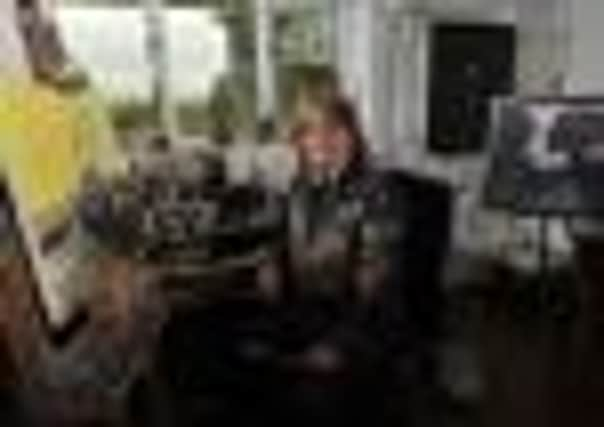A new portrait of the artist


I’m in a small fishing boat on a choppy sea speaking to a camera which is on an even smaller boat bouncing along behind. The director standing next to the lurching cameraman is David Beresford, a flamboyant chap in a big hat. He’s shouting something to me, something I can’t quite catch: is he saying “Action”? Is he yelling “Cut”? I strain to hear and he shouts louder. ‘“I wish I was at home painting!” he bellows as both boats sway in different directions and the sound man turns a more interesting shade of green. But more of green later.
Fast forward to the spring of 2012 and I’m in David’s kitchen in Weeton, just the other side of Harewood, and he’s bringing out his latest paintings to show me. He keeps carrying more and more in and standing them against the cupboard near the Aga.
Advertisement
Hide AdAdvertisement
Hide AdHe’s still a flamboyant man in a big hat and the paintings are remarkable; somehow he manages to capture the light that changes hourly in this part of the county that’s almost North Yorkshire and more or less West Yorkshire and, on the day I visit, is wearing a scarf of constant drizzle, the kind that wets you through as they say. Well, it makes interesting shades of green in the woods beyond David’s window. I’ll return to green later.
David Beresford is one of more than 130 artists throwing their doors wide for the North Yorkshire Open Studios event this weekend. The Open Studios idea has been around for a while now, and it’s a beautifully simple one; for many people art can be a bit of a mystery, a perfumed meeting of a secret society they only a few people in berets are invited to. Open Studios dispels that myth by inviting everybody to come and see the artists at work, to view that studio, that lathe, that bench, that potter’s wheel. Maybe some art will be bought, but often the talking is just as important, the glimpse into a world that’s not really as threatening as it seems. And you really don’t need a beret.
David was born in Thurnscoe in South Yorkshire in 1946 and went to Barnsley School of Art; he then trained in London and, like many people in the giddily exciting 1960s and 1970s, went into television. He worked on classic programmes like In Loving Memory and Last of the Summer Wine but he always painted in his spare time, and always wanted to make it more of a job than a hobby.
In 1994, he directed a community opera in Thurnscoe called Lullaby Tunnel about a pit disaster at the nearby Barnburgh Colliery on the site of the recently-closed Hickleton Main coal mine, and in 1995 we started working together making television programmes.
Advertisement
Hide AdAdvertisement
Hide AdIn those days his artworks were gloriously odd and strange; when we came back from Mexico he painted images of the landing strip we jolted down onto in a little 16-seater plane, hanging on for dear life as a placid woman in the front row breastfed her huge baby, and a loud roofscape of the school opposite our hotel in Mexico City which had no playing fields but a bright and interesting green artificial lawn on the roof. But more of green later.
The canvases he’s bringing into his kitchen are different, though; they’re calmer. They’re landscapes. They’re somehow serene. Unlike some artists, he talks well about his work: “I was getting stuck” he says, “I was running out of ideas, going up blind alleys, and then I told myself to just look around, just look around me. It’s all here…” He clutches his head as he talks, trying to explain himself to himself as well as to us. He goes to get another painting.
He’s a deeply practical man with a streak of romance and dash of the inventor; he built his studio out of straw bales, then plastered it so that it looks like an adobe hut. He’s got several sheds that he built himself, and poly tunnels and an outdoor oven. As we stand in the kitchen he extols the virtues of making your own yoghurt and he shows me a photograph of his new goslings. There’s an endless, restless, creativity about him. And he’s constantly singing “The Sheikh of Araby”. I’m not sure why.
The works you’ll see if you visit his studio are often about the lanes around his house and the views from his garden. As he says, there’s something mysterious, almost mythical, about the idea of The Lane, and something very English, too. It’s that old notion of the universal in the local, I reckon; the notion that we can see the universe from our back yard.
Advertisement
Hide AdAdvertisement
Hide AdDavid sets another painting down. I’m reduced to murmuring in appreciation because after a while I run out of things to say.
He clutches his head again. “Green is so hard.” He says, taking his hat off and running his paint-stained hands through his hair. “How do you do green, Ian? How do you get it right?”
I told you I’d return to green. It’s easy for me, to be honest: I just write the word and there it is. It’s much harder for painters, of course, and that’s what makes art so interesting.
So go and have a look at David’s work in his straw bale studio. Ask him about the colours in Mexico. Ask him about the colours in Otley. And ask him how he captures green.
North Yorkshire Open Studios today and tomorrow June 9/10 and 16/17: www.nyos.org.uk
David Beresford: Park View, Weeton Lane, Weeton, LS17 0BG www.davidberesfordart.co.uk